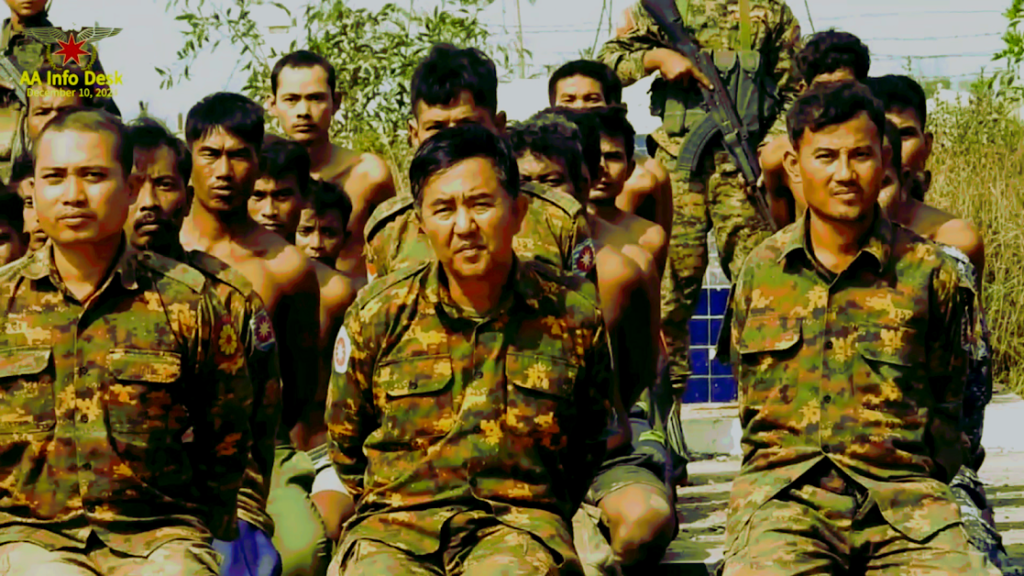Myanmar Spring Chronicle – December 11 Perspective
MoeMaKa, December 12, 2024
The Impact of the Fall of Border Guard Post (5) in Maungdaw and the Arrest of a Colonel
In recent days, the Arakan Army (AA) seized control of the last remaining military outpost in Maungdaw Township, Border Guard Sub-post (5). Reports state that Colonel Thurein Tun, the commander of Operation Command Headquarters 15, and dozens of junta troops were captured during the operation. Since early August, AA forces had been blockading the post, and after more than three months, it finally fell, resulting in the capture of the commanding officer.
After the fall of Operation Command Headquarters 15 in Maungdaw Township, Colonel Thurein Tun, the commander stationed at Border Guard Sub-post (5), was among those resisting as the last remaining border guard outpost in the northwestern region of Rakhine State. At present, only a few towns remain under junta control, including Sittwe, Kyaukphyu, Mrauk-U, Ann, and the western military headquarters in Gwa. Notably, AA has already seized Ann, leaving only the military compound at the regional headquarters intact.
The military junta in Naypyidaw has been unable to provide sufficient logistical support—such as food, weapons, and reinforcements—for the remaining military outposts in Rakhine. This lack of support raises concerns that the junta troops will become demoralized and unable to resist further. The capture of the commanding officer by the enemy highlights weaknesses in planning, inadequate logistical support, or poor leadership among military officials, which could lead to further dissatisfaction within the junta’s forces.
The siege and fall of military outposts and towns in Rakhine, accompanied by significant casualties and the capture of troops, is not a typical battlefield occurrence. It points to poor command, weak leadership, and orders that fail to reflect the realities on the ground—common issues within poorly managed armed forces.
Earlier this year, when battalions retreated from Kyauktaw in Rakhine State, they experienced similar difficulties when AA forces launched coordinated land and water attacks along the Kaladan River. During the southern Rakhine battles in Thandwe and Ngapali Beach, there were also incidents where naval rescue efforts resulted in junta troops being mistakenly fired upon by their own naval vessels.
In the recent Border Guard Post (5) battle, insufficient rear support once again resulted in dozens of troops falling into enemy hands, without adequate rescue efforts being made. This has further dampened morale among junta soldiers.
At a time when junta troops in Rakhine face extreme hardships—being captured, sustaining heavy casualties, and enduring the worst circumstances—Senior General Min Aung Hlaing, the military leader, is seen celebrating sports events in Naypyidaw. This demonstrates a lack of attention to the situation and will likely create resentment among his forces.
While the military junta may believe it still controls large swathes of territory, its rapid loss of ground in Rakhine, Kachin, and Shan States—especially during Operations 1027 (both phases)—reveals a reality they can no longer ignore.
As the risk of losing more territories grows, the military leader’s attendance at sports ceremonies and other ceremonial events undermines the sacrifices of his troops on the ground. This behavior sends the message that he does not value the soldiers who are fighting and dying for the regime.
History shows that dictators often fail to understand the reality of their crumbling power, even as they lose control and are forced to flee or face defeat. Senior General Min Aung Hlaing’s actions mirror those of authoritarian leaders who cling to ceremonies and public displays of normalcy, giving speeches and waving to crowds while their regimes collapse. This inability to address the situation reflects the junta’s disconnection from the reality of its military failures.

